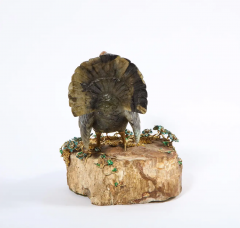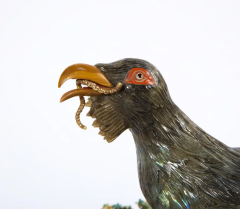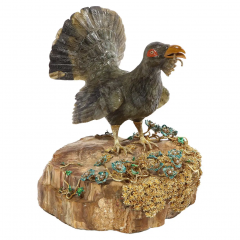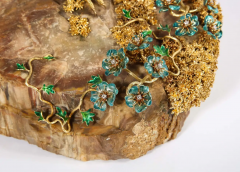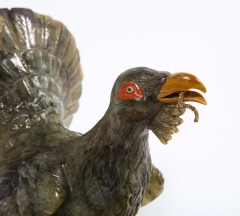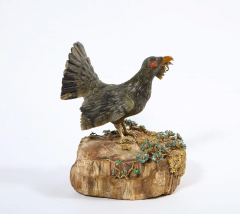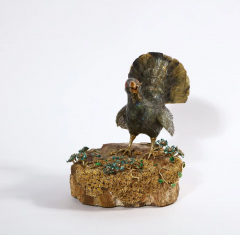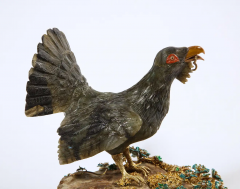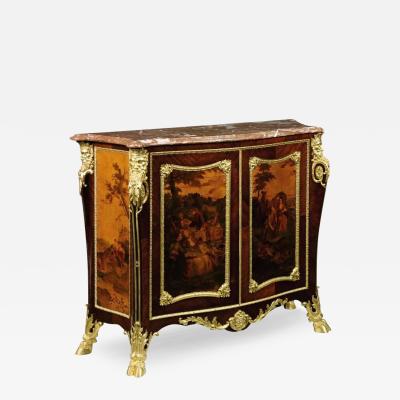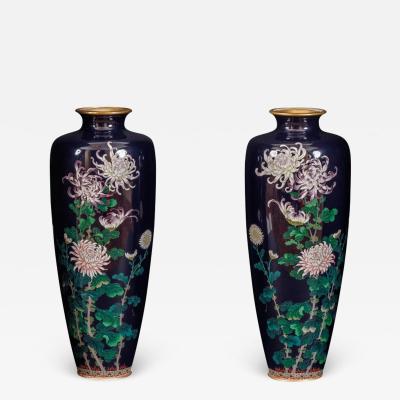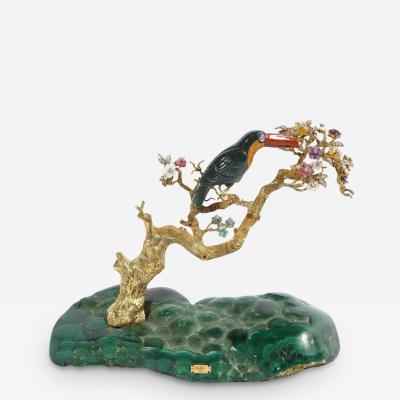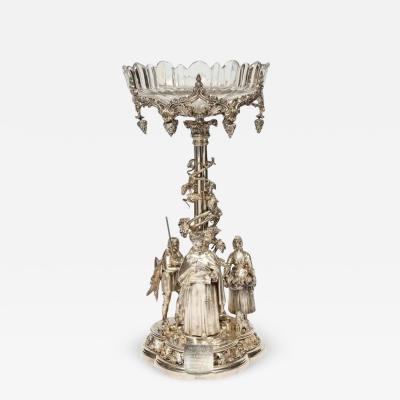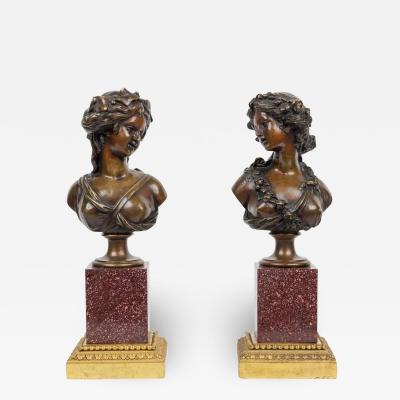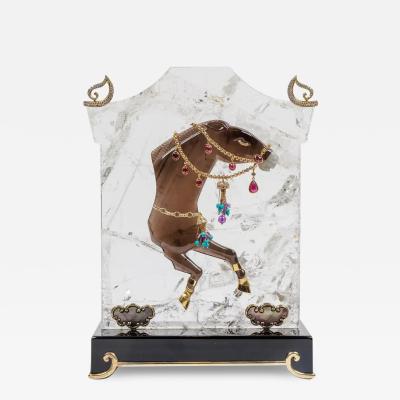Rare 18K Gold, Enamel and Diamond Mounted Carved Labradorite Turkey Bird
-
Description
A rare 18K gold, enamel and diamond mounted carved labradorite turkey bird sculpture on a petrified wood base, attributed to Manfred Wild, Idar-Oberstein, Germany.
Very finely crafted of the highest quality and best color Madagascar labradorite with excellent labradorescence. The entire hand carved turkey displays and excellent shimmer effect known as labradorescence.
Madagascar labradorite, rich in the phenomenal characteristics of this remarkable gemstone which displays an ever-changing sheen, that is extremely suitable for the rendering of this turkey bird.
Extensive gold mounts of flowers with diamonds and enamel.
A truly exceptional and rare gold mounted jeweled object. A true collectors piece.
Measures: 9" high x 7.5" wide x 7" deep.
Weighs approximately 12 pounds.
Very good condition. No damages noted.
Born in 1944, Manfred Wild, an eighth-generation gem cutter, is one of the most renowned lapidary artists to emerge from Idar-Oberstein. At the age of twenty, during an apprenticeship with a gemstone merchant, he began his well-rounded educational journey in the areas of fine art, gemstone cutting, engraving and goldsmithing.
Working in a family tradition of stone cutters established in 1630, Manfred Wild is one of the world's most famous creators of objets d'arts. He is best known for his virtuoso work in rare, precious and semi-precious materials carved as perfume bottles, animals, whimsical figures, flower studies, enameled eggs with concealed "surprises", cameos, chalices and objets de fantaisie made of precious stones, gold and silver.
It is helpful, of course, to understand Wild's work within the greater context of 19th and 20th Century Decorative and Jewelry Arts. In addition to the influence of his own family and town, Mr. Wild follows the traditions established by René Lalique and Peter Carl Fabergé (Russian jeweler, 1846-1920) and a great number of parallels can be seen in their work. Fabergé had begun a new era in the Jewelry Arts. Prior to him, many jewelers felt the value of jewelry was intrinsic, based upon the stones (particularly diamonds) and precious metals. The artistic creativity and superior craftsmanship introduced by Fabergé made such objects transcend their "break value". Fabergé also used a number of decorative techniques attributable to French 18th Century goldsmiths, e.g. the art of guilloché, a surface treatment of metal that could make waved lines or striations in the design, either performed by machine or by hand. Atop the guilloché decoration was a translucent enameling that required the application of several coats and the "firing" of the object in an oven after each layer, a very labor-intensive technique. The limited palette of enamels used in the 19th century was expanded upon by Fabergé who, after much experimentation, arrived at over 140 shades. He also used natural stones often found in his local area or native to Russia, e.g. jasper, agate, rhodonite, bowenite and nephrite. Often his use of precious stones, including sapphires, rubies and emeralds was in an understated way, only for accents, and even then were used en cabochon. Diamonds, if used, were typically rose-cut. So many of the aforementioned decorative elements are seen the work of Wild even as they appear in the examples on these pages. When India Early Minshall, a wealthy collector of Fabergé who purchased an egg in 1944, stated "Fabergé was called the Benvenuto Cellini of the North, but I do not think any jeweler can ever be compared to him"—She could not know that someday the work of Manfred Wild would rival the work of the great Russian jeweler......
Mr. Wild's works are displayed in museums throughout the world including: The German Gemstone Museum in Idar-Oberstein, The Smithsonian Institution in Washington, D.C., The Harvard Museum in Boston, The Carnegie Museum in Pittsburgh and The Iksan Jewellery Museum in Korea, as well as extensive private collections in Japan, Europe, the Middle East, and the United States of America. -
More Information
Origin: Germany Period: 1900-1919 Condition: New. Very Good Condition Styles / Movements: Traditional Incollect Reference #: 532518 -
Dimensions
W. 8 in; H. 9 in; D. 7 in; W. 20.32 cm; H. 22.86 cm; D. 17.78 cm;
Message from Seller:
For four generations, Solomon Treasure has built a distinguished reputation for offering rare and important 18th-19th century antiques and fine art, serving museums, collectors, and designers worldwide. Located in the heart of Manhattan, we specialize in exceptional pieces ranging from Napoleon Neoclassical to Art Deco and Middle Eastern Islamic treasures. Contact: Mory Talasazan, Director | mory@solomontreasureny.com | 917.686.9732 |


















